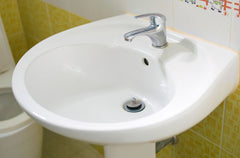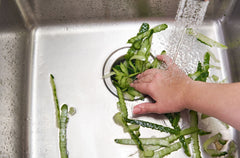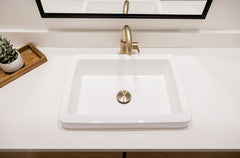Ever tried to use your kitchen sink, only to hear a weird gurgling noise or see water rising instead of disappearing? These are often the first signs that your disposal might be clogged. It's an experience many of us have faced and frankly, it's never pleasant. Figuring out why your disposal is blocked and learning how to handle it can help you tackle the problem with confidence. You may recall the last time you had friends over for dinner, only to suddenly find yourself frantically unblocking the disposal. A few simple steps could have made all the difference.
Clogs in garbage disposals often happen due to a few common culprits. Whether it's the peels of your favorite potatoes, greasy leftovers, or fibrous vegetable bits that sneak past the strainer, all these pesky items can cause trouble. Understanding what causes these issues means you can avoid some of them in the future. Before you reach for your plumber's number, explore a straightforward way to identify, handle, and prevent disposal clogs.
Identify the Blockage
Before solving the clog, it's crucial to identify what's causing the blockage. Finding the source can make all the difference in effective troubleshooting. What should you be looking for?
1. Visual Inspection: Start by peering down the disposal with a flashlight. Without putting your fingers inside, look for any visible obstructions. The glaring shine of a lost cutlery piece or a bundle of fibrous food could be the issue.
2. Listen for Unusual Sounds: If you hear grinding sounds or silence, it might signal trouble. The grating noise can mean a hard object is in contact with the blades, while silence indicates a jam.
3. Common Offenders: Keep an eye out for usual suspects like eggshells, coffee grounds, and fibrous foods; these can pack tightly and resist flowing away. It’s often surprising what ends up down there, and knowing what to avoid can help prevent future headaches.
Understanding these signs and culprits gives you an edge, allowing you to tackle the issue before it worsens. The key here is a careful inspection, using your senses to locate the troublesome spot in the disposal system.
Safety First: Turning Off the Power
Before getting hands-on with the disposal, prioritize safety. Always ensure the disposal is completely off to avoid accidents. Here's how to do it safely:
- Unplug the Unit: Make sure the disposal is switched off at the wall socket, and if possible, unplug it completely. Reaching under the sink might be awkward, but it's simple and necessary for safety.
- Find the Circuit Breaker: Locate your home's breaker panel and turn off the specific switch for the kitchen disposal. This is a double assurance that the unit won’t accidentally come alive.
- Use a Multi-Tool: In some cases, using tools like pliers or tongs can help avoid direct contact, ensuring your hands stay clear.
By taking these safety steps, you're creating a safe space to work on the disposal. Forgetting to disconnect the power could turn a minor problem into a major injury. A little precaution goes a long way in keeping you out of harm's way.
Manual Removal of Debris
Once the disposal is safely disconnected, it's time to tackle the debris head-on. This process requires a bit of patience and the right tools. Start by shining your flashlight into the disposal to see what you're dealing with. You might spot a small piece of bone or a stubborn collection of vegetable peelings.
- Get the Right Tools: Grab a pair of pliers or tongs. These will help you reach down and pull out any debris without putting your fingers at risk.
- Gently Extract Obstructions: Focus on removing visible objects. Be gentle to avoid damaging the blades. If something is wedged tightly, you might need to wiggle it back and forth to loosen it before pulling it out.
- Be Thorough: Once the major pieces are out, take a closer look. Smaller bits might still be lurking that can cause problems later on.
This hands-on approach might not be the most glamorous part of the job, but it's crucial to clearing the pathway for smooth operation again.
Resetting the Disposal
After clearing out the debris, resetting your disposal can help get it back on track. If it has been turned off due to overload, most disposals come equipped with a reset button.
- Find the Reset Button: Typically located at the bottom or side of the unit, the reset button is usually small and red.
- Press and Hold: Hold the button down for a few seconds to reset the motor. If successful, you'll often hear a click.
- Check the Impeller Blades: Make sure that the blades inside the disposal are free to move. Use a small wooden spoon to gently turn the blades and ensure they aren't stuck.
By following these steps, you should have your disposal functioning like new, ready to tackle whatever you toss its way.
Final Tests and Preventative Measures
To confirm the job is complete, there are a few final checks and ongoing practices you can adopt. These last bits ensure a long-lasting, clog-free disposal.
- Run Water: Turn the water back on and let it run through the system. This rinse helps flush away any remaining particles and confirms the clog is fully cleared.
- Test the Disposal: Turn the disposal back on briefly to listen for any unusual sounds. By operating smoothly, you know the blockage is eliminated.
- Prevent Future Clogs: Adopt simple habits like running cold water during use and avoiding fibrous or greasy foods. These practices can greatly reduce the chance of future blockages.
Regular maintenance and care will keep your disposal in top condition and prevent similar headaches in the future.
A Reliable Solution for Recurring Issues
Sometimes, despite our best efforts, blockages can become a frequent issue. If you find yourself constantly dealing with clogs, professional help may be the best course of action. Professionals have the experience and tools necessary to diagnose and solve deep or persistent issues, ensuring your disposal operates smoothly long-term.
While we've covered the essential DIY steps in this guide, don't hesitate to reach out to experts when the problem persists beyond simple fixes. They can provide a thorough inspection and offer peace of mind knowing your kitchen remains clog-free.
For persistent kitchen woes when it comes to dealing with garbage disposals, consider exploring proven methods on how to unclog disposal effectively. Visit The Shroom Company and discover our Kitchen SinkShroom stainless strainer with built-in anti-clog technology. It's designed to keep your disposal running smoothly while providing peace of mind with every use.




0 comments